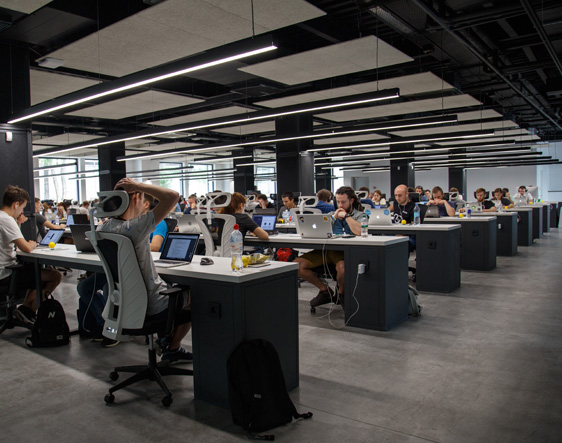The early days of my company, SquareFoot, we had a small group of people. So it was easy for me to have my eyes and ears on what was happening every day. Things literally had to circle through me to get done. But as the organization got bigger, and we moved to a different office that could accommodate our growing team and mounting needs, communication and collaboration was at risk. Contributor Jonathan Wasserstrum – Founder and CEO SquareFoot.
I wanted to give my dozens of team members room to operate and run their portions of the business. At the same time, though, I wanted to find a way to stay up to date on what was happening, beyond what would get reported back to me at weekly check-ins or occasional all-hands meetings. So I decided I’d place my seat in the office right in the heart of the action, and make myself a visible and valuable member of the team.
The hope was that as people — both junior and senior members of the team – saw me at my desk as they passed, they’d stop to chat. In addition, by sitting in close proximity to them, on the floor rather than in a distant office at the back of the office, I could absorb the interactions happening around me and discover the intricacies and complexities that were being discussed. It wouldn’t always be my call on how to proceed, but I liked the idea of being clued into the problem-solving taking place around me.
Lastly, and perhaps most importantly, this decision gave all employees, especially young ones, more access to stop by with a quick question that could make all the difference for them. I know from my experience coming of age in commercial real estate over a decade ago that having the ear of the company’s CEO is difficult to come by. So what do you do when he’s the one who holds the answer to your essential question? I knew that when these issues came up they’d want to come find me, and this way I was making it easier on all of us to bread down any perceived barriers. I could, and do, offer them mentorship and guidance at a level that might have been impossible otherwise.
There are some downsides that surface from such an innovative solution, however. There are times when I require more privacy, to either work on more confidential matters or to field an important phone call. For those occasions, I book and head to a nearby conference room, just like other members of the team would in similar circumstances. But I know that these moments are few and far between.
As a CEO, I spend many hours of my day away from my desk either in meetings onsite or speaking with people at other locations around New York City, where we’re headquartered. We help growing businesses here and in dozens of other national markets in the United States to identify and move into their next office spaces, and that work requires me to meet regularly with people for both showings and other networking opportunities. When I do have a precious few hours a day at my desk, I want my team to know that I’m available to them, to assist them however I can.
Because office space is my area of expertise, I think a lot about office layout and office design. This is the structure that works best for me and for my team. But that doesn’t mean it’s the only design that leads to success, and it’s definitely not necessarily the right choice for all CEOs and all companies. Every decision about offices, down to the front doors you select, can impact the way people perceive and then use the space. This is not intended to overwhelm someone looking for space, rather the opposite: If you can anticipate ahead of time what your employees will want, and then choose and build out the space to reflect your company’s values and needs, you’ll save yourself a lot of time and hassle.
Make the investment into the office that suits you and your team. In my team’s case, my decision on the size and shape of the office was heavily influenced by my desire to sit in the middle of the room, within a couple dozen feet or so of everyone. I didn’t want to take on a space for us that would leave me feeling removed from the team. Every CEO must weigh what matters most to them and how they envision their employees using the space ahead of taking office tours. Something I’ve learned along the way is that the more information you can supply to a broker at the outset, the faster you’ll wind up finding your perfect space.
So the advice I have for other executives is not to sit in the middle, like me. Only do that if it makes sense for you and for your organization. What I do want to impart, though, is that choosing office space necessitates being thoughtful and deliberate about what you’re seeking from the space and in turn from your employees. Whatever you decide to do, they’ll look to follow your lead.









